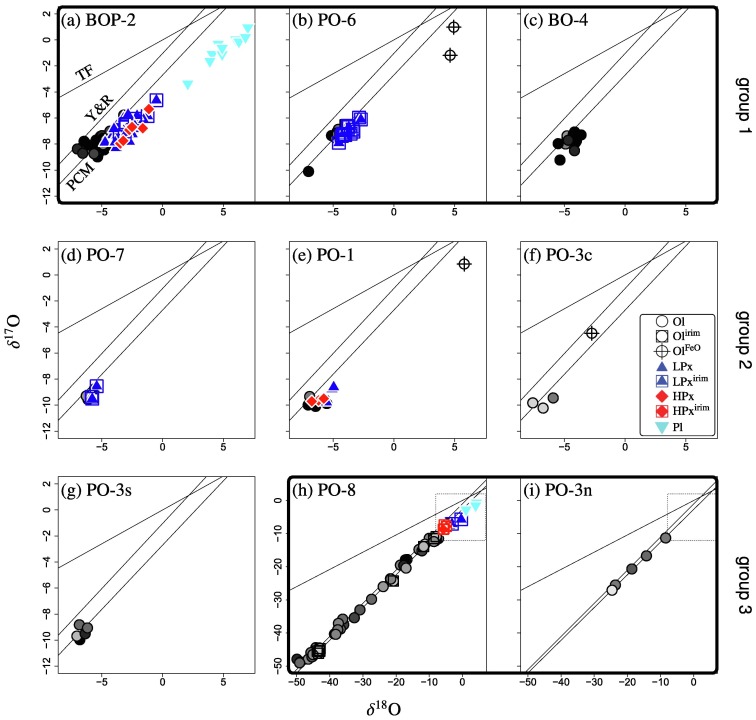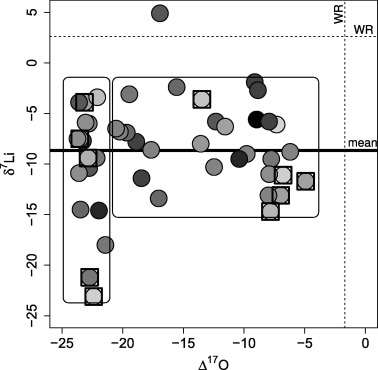Lithium- and oxygen-isotope compositions of chondrule constituents in the Allende meteorite
Type 3 carbonaceous and ordinary chondrites have long been considered as primordial materials, relatively unchanged since their formation; however, most have been altered by interaction with aqueous fluid on their parent asteroids. Lithium is highly soluble in aqueous fluids and Li isotopes exhibit significant fractionation in geologic materials (δ7Li ranges from −20 to 40‰) because of the large mass difference between 6Li and 7Li. Solid phases preferentially retain 6Li, while 7Li preferentially enters solution. These unique geochemical characteristics of Li make it possible to trace aqueous alteration processes on asteroids.
Chondrules are the most abundant components in most chondrites and are believed to have formed in the solar nebula from clumps of precursor dust during repeatable transient heating events. Chondrules are composed of olivine, low-Ca pyroxenes, high-Ca pyroxenes, plagioclase, glass, metal, and sulfides. These phases respond differently to nebular and asteroidal processes. Variations of Li-isotope compositions observed in the above phases could have resulted from those of chondrule precursors, isotope fractionation between silicates and melt, devolatilization, condensation, and interaction with isotope reservoirs, during nebular and asteroidal processes. Fully constraining the behavior of Li in these meteorites requires a more comprehensive approach involving analyses of a broader array of element and isotope compositions than previously investigated.
The Allende chondrules were measured for their oxygen-isotope compositions and these analyses are shown in Figure 1. On the O isotope diagram shown in Fig. 1, δ18O and δ17O values of chondrule minerals (olivine, low-Ca pyroxene, high-Ca pyroxene, and plagioclase) scatter around the PCM (primitive chondrule mineral) line (slope of 0.987 and intercept of −2.70 and the Y&R line (slope of 1.00±0.03 and intercept of −1.04. These O-isotope compositions are in good agreement with those previously obtained by whole rock and in situ analyses of CV chondrules.

Based on the O-isotope composition of the olivines, the nine chondrules studied here were divided into three groups. Average Δ17O values of olivine (Fo>65) in chondrules BOP-2, PO-6, and BO-4 (group 1) are −5.3, −5.2, and −5.4‰, varying by < 1‰ (1SD). Average Δ1717O values of olivine (Fo>65) in chondrules PO-7, PO-1, PO-3c, and PO-3s (group 2) are −6.1, −6.5, −6.3, and −6.0‰, varying by < 1‰ (1SD). The average Δ17O of olivine compositions in chondrules of group 1 and 2 are −5.3±0.4 and −6.2±0.4‰, respectively. Olivines in chondrules PO-8 and PO-3n (group 3) show variations in Δ17O from −23.7 to −6.2‰.
The Allende CV3 meteorite consists of chondrules, refractory inclusions and matrix and experienced significant alteration. Prior to investigation of Li behavior, we will evaluate the petrogenesis and alteration of Allende chondrule constituents.
Olivine occurs as phenocrysts and relict grains in chondrules (Ol) and igneous rims (
Considering that chondrules experienced multiple heating events and asteroidal alteration, the 7Li/6Li heterogeneity could be caused by high temperature fractional crystallization, devolatilization, and diffusion. Although ti is assumed the isotope heterogeneities observed in ordinary chondrite chondrules were inherited only from precursors, our combined O- and Li-isotope study of the Allende chondrules can distinguish between the Li-isotope heterogeneity produced before, during and after chondrule formation. Group 3 chondrules contain relict olivines which are overgrown by olivine, which crystallized from chondrule melts and their range of O-isotope compositions is inherited from precursors. Also group 3 olivines maintain variations in Li isotopes of the precursors that formed prior to chondrule formation and igneous-rim formation. Since the number of analyses for chondrule PO-3n is limited, we focus on group 3 chondrule PO-8 that preserves significant variation of both O- and Li-isotope compositions. The δ7Li as a function of Δ17O for group 3 chondrule PO-8 is shown in Fig. 2. Olivines in group 3 chondrule PO-8 have different Δ17O and δ7Li values, which reflects either distinct relicts or melt. We see that variation of δ7Li differs depending on values of Δ17O. The Li-isotope composition varies from δ7Li −23‰ to −3‰ with an O-isotope composition close to that of refractory inclusions (−25 < Δ17O < −20‰) and is relatively constant (−8 ± 4‰), when the O-isotope composition is in between Δ17O −20‰ and −5‰. Note that average Li-isotope compositions of group 3 olivines (δ7Li ∼ −8‰) is consistent with that of the chondrule melt (δ7Li ∼ −10‰) estimated from group 1 olivines. We infer that even with a constant Δ17O (−25 < Δ17O < −20‰), δ7Li is distributed heterogeneously, probably reflecting kinetic processes.

References:
- Tak Kunihiro, Tsutomu Ota, Eizo Nakamura. Lithium- and oxygen-isotope compositions of chondrule constituents in the Allende meteorite, Geochimica et Cosmochimica Acta, 252, 107-125 (2019). doi:10.1016/j.gca.2019.02.038, dream/20190306171521-621773.